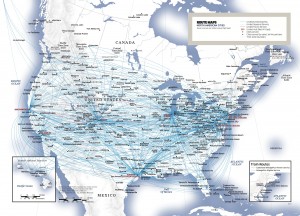Reflection on Airlines’ Spoke-Hub Network after O’Hare Fire
A contract worker set a fire at an air-traffic control center last Friday, which all but paralyzed the Chicago airline hub, caused cancellation of more than 3,500 flights flying out of Chicago, and continues to affect more flights.
Chicago is one of the busiest airline hubs in the nation. In fact, its major airport, O’Hare International airport just reclaimed its title of “the world’s busiest airport” this month, surpassing Atlanta International Airport for the first time since 2004.
The first question is: why is Chicago so busy? It is true that Chicago is the most populous city in the Midwest, but there is another fact that should be factored in.
The logistic model that most airlines adopt today is the spoke-hub model, in which all air traffic moves along spokes to a  centered hub. As opposed to the point-to-point system, many passengers first move to the hub and make connecting flights instead of going to their destinations directly. The domestic route map of United Airlines effectively illustrates how the spoke-hub system works. We can clearly see that flights are largely centralized at the airline’s hubs (airports in red fonts). There are a couple of major advantages of this system, compared to the point-to-point one. First, airlines are able to connect all destinations with fewer routes. For example, if an airline provides service in 10 cities, with a single hub, it only requires 9 routes to reach all destinations. In contrast, the point-to-point system requires 45 routes. Fewer routes allow airlines to purchase fewer planes and employ less staff in order to cut budget and improve efficiency. Also, aircraft are more likely to fly at full capacity. This not only saves airlines a lot of money, but also lowers ticket price for passengers since the cost of carrying each passenger decreases. In addition, whenever the airline wants to add another destination, it only needs to add a few routes to hubs to include the new destination in its network.
centered hub. As opposed to the point-to-point system, many passengers first move to the hub and make connecting flights instead of going to their destinations directly. The domestic route map of United Airlines effectively illustrates how the spoke-hub system works. We can clearly see that flights are largely centralized at the airline’s hubs (airports in red fonts). There are a couple of major advantages of this system, compared to the point-to-point one. First, airlines are able to connect all destinations with fewer routes. For example, if an airline provides service in 10 cities, with a single hub, it only requires 9 routes to reach all destinations. In contrast, the point-to-point system requires 45 routes. Fewer routes allow airlines to purchase fewer planes and employ less staff in order to cut budget and improve efficiency. Also, aircraft are more likely to fly at full capacity. This not only saves airlines a lot of money, but also lowers ticket price for passengers since the cost of carrying each passenger decreases. In addition, whenever the airline wants to add another destination, it only needs to add a few routes to hubs to include the new destination in its network.
The use of spoke-hub model in air industry brings about some interesting results. One of them is that airlines often price tickets from one city to another through a hub cheaper than tickets that terminate at the hub, because there may be more competition between the two cities that are cheaper. For example, United operates service between Ithaca and Newark (NYC area). However, if you do a bit of searching, you will find a round trip ticket between Ithaca and Newark may cost much more than that between Ithaca and, say, Washington DC with a stop at Newark. This seems very counterintuitive – you travel more miles but pay less. This phenomenon even inspired a new way of booking cheaper flight tickets, called “hidden city ticketing” — you buy the flight to the cheaper destination, connecting where you really want to go, and just get off the plane at your ‘true’ arrival point. (Throwing away the final segment, throwaway ticketing.)
Let’s shift the gear back to the O’Hare snarl. O’Hare airport is hub for both United Airlines and American Airlines. This means O’Hare is not only for passengers traveling from and to Chicago, but also serves as a transit center for United and American passengers originating from other cities across the country. In other words, the scope of the area suffering from the fire far exceeds the city limits of Chicago. As the Chicago hub is disrupted, almost all travelers in the nation are somewhat affected.
The chaos following the fire exposes one of the disadvantages of the spoke-hub network — the hub is the single point of failure in the network. Any incident at the hub may cause huge consequences throughout the entire system. It is almost impossible to divert all traffic to spokes and circumvent the hub. Once the hub fails, the whole network will be paralyzed.
Therefore, the airline industry has to figure out a more efficient way to minimize the unpredictable consequence whenever a hub is shut down.
Articles:
FAA to review facilities after Chicago air-traffic snarl – http://www.usatoday.com/story/news/nation/2014/09/29/faa-huerta-atca-controllers/16417777/
Chicago Flights Still Disrupted Two Days After Fire At FAA Facility – http://www.weather.com/news/chicago-flights-fire-faa-facility-20140928
How Airlines Work – http://science.howstuffworks.com/transport/flight/modern/airline3.htm
